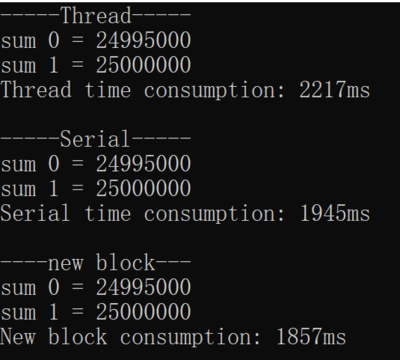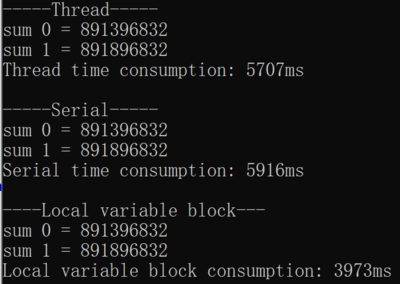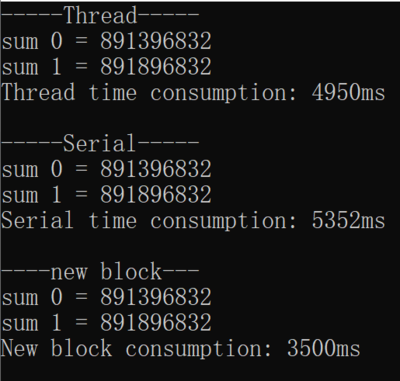Difference between revisions of "GPU621/Analyzing False Sharing"
Ryan Leong (talk | contribs) (→Example Of A False Sharing) |
Ryan Leong (talk | contribs) |
||
| Line 6: | Line 6: | ||
= '''Solutions Of False Sharing''' = | = '''Solutions Of False Sharing''' = | ||
| − | == | + | == Using local variable == |
#include <thread> | #include <thread> | ||
#include <vector> | #include <vector> | ||
| Line 137: | Line 137: | ||
So the problem of false sharing sometimes cannot be generalized, and the occurrence of false sharing does not necessarily make performance lower. But no matter how the new block is the optimal solution. | So the problem of false sharing sometimes cannot be generalized, and the occurrence of false sharing does not necessarily make performance lower. But no matter how the new block is the optimal solution. | ||
| − | == | + | == Byte alignment == |
If you think the above example is too limiting, not all cases can be abstracted to such a local variable. So let's let the two variables exist on different cache lines! | If you think the above example is too limiting, not all cases can be abstracted to such a local variable. So let's let the two variables exist on different cache lines! | ||
Revision as of 10:07, 26 November 2022
Group Members
Solutions Of False Sharing
Using local variable
#include <thread>
#include <vector>
#include <iostream>
#include <chrono>
using namespace std;
const int sizeOfNumbers = 10000; // Size of vector numbers
const int sizeOfSum = 2; // Size of vector sum
void sumUp(const vector<int> numbers, vector<long>& sum, int id) {
for (int i = 0; i < numbers.size(); i++) {
if (i % sizeOfSum == id) {
sum[id] += I;
}
}
// The output of this sum
cout << "sum " << id << " = " << sum[id] << endl;
}
int main() {
vector<int> numbers;
for (int i = 0; i < sizeOfNumbers; i++) { //Initialize vector numbers to 0 to 100
numbers.push_back(i);
}
cout << "-----Thread-----" << endl;
// Thread block
{
vector<long> sum(sizeOfSum, 0); //Set size=sizeOfSum and all to 0
auto start = chrono::steady_clock::now();
vector<thread> thread;
for (int i = 0; i < sizeOfSum; i++) {
thread.emplace_back(sumUp, numbers, ref(sum), i);
}
for (int i = 0; i < sizeOfSum; i++) {
thread[i].join();
}
auto end = chrono::steady_clock::now();
cout << "Thread time consumption: " << chrono::duration_cast<chrono::microseconds>(end - start).count() << "ms" << endl;
}
cout << endl << "-----Serial-----" << endl;
// Serial block
{
vector<long> sum(sizeOfSum, 0);
auto start = chrono::steady_clock::now();
for (int i = 0; i < sizeOfSum; i++) {
sumUp(numbers, sum, i);
}
auto end = chrono::steady_clock::now();
cout << "Serial time consumption: " << chrono::duration_cast<chrono::microseconds>(end - start).count() << "ms" << endl;
}
}
In this program code, we can see that at the beginning of the main function we declare a vector numbers and initialize it from 0 to 100. We can also see in the main function that the code is divided into two main blocks. The first block is the Thread block, which is executed concurrently using multiple threads. While the second block is the Serial block, it is executed concurrently using normal serial logic.
The main purpose of the sumUp function is to calculate the sum of odd elements or even elements based on the data in the first vector argument in the argument list. Also, the sum will be recorded in the corresponding position of the second vector argument using the int argument as the index.
Which block of code do you think will take less time?
Theoretically, this code should be executed faster on a multicore machine with a Thread block than a serial block. But the result is.
Or
Or this
To our surprise, the serial block took much less time, no matter how many times I ran it. This turned our existing knowledge upside down, but don't worry, it's because you don't understand False Sharing yet.
As we said above, the smallest unit of CPU operation on the cache is the size of a cache line, which is 64 bytes. As you can see in our program code, the sum is a vector that stores two long data types. The two long data are in fact located on the same cache line. When two threads read and write sum[0] and sum[1] separately, it looks like they are not using the same variable, but in fact, they are affecting each other.For example, if a thread updates sum[0] in CPU0, this causes the cache line of sum[1] in CPU1 to be invalidated. This causes the program to take longer to run, as it needs to re-read the data.
We try to change the sizeOfSum to 8, which means that changing the size of the vector sum to 8 and the if condition in the sumUp function to i%8==id will give the program more data to process. Nevertheless, the result still does not bring the time between the Serial block and Thread block closer and the Serial block still takes less time.
What would it take to show the advantages of multicore? As you can see in our program, multiple threads are not operating on the same variable, but only a single thread is reading and writing a lot of variables in the same cache line, so you can introduce a local variable.
We implement another function newSumUp in the program code:
void newSumUP(const vector<int> numbers, vector<long>& sum, int id) {
long thisSum = 0;
for (int i = 0; i < numbers.size(); ++i) {
if (i % sizeOfSum == id) {
thisSum += i;
}
}
sum[id] = thisSum;
cout << "sum " << id << " = " << sum[id] << endl;
}
Also, we add the following code to our main function:
cout << endl << "----new block---" << endl;
// new block
{
vector<long> sum(sizeOfSum, 0);
auto start = chrono::steady_clock::now();
vector<thread> thread;
for (int i = 0; i < sizeOfSum; ++i) {
thread.emplace_back(newSumUP, numbers, ref(sum), i);
}
for (int i = 0; i < sizeOfSum; ++i) {
thread[i].join();
}
auto end = chrono::steady_clock::now();
cout << "New block consumption: " << chrono::duration_cast<chrono::microseconds>(end - start).count() << "ms" << endl;
}
When we ran the program again, we came to this conclusion:
We can see that the new block is already much faster than the Thread block, and even comparable to the Serial block is almost the same. But overall the Serial block is still the least time-consuming because the new block still needs to incur extra overhead for thread creation and scheduling.
We could try increasing sizeOfNumbers to 1000000 as well, which would allow the program to process more data, thus compensating for the extra overhead of thread creation and scheduling.
Now we can already see the advantage of multi-threading. Even when the vector numbers reach the size of 1000000, the Thread block even runs faster than the Serial block.
So the problem of false sharing sometimes cannot be generalized, and the occurrence of false sharing does not necessarily make performance lower. But no matter how the new block is the optimal solution.
Byte alignment
If you think the above example is too limiting, not all cases can be abstracted to such a local variable. So let's let the two variables exist on different cache lines!
#include <thread>
#include <iostream>
#include <chrono>
using namespace std;
struct Number {
int num1;
int num2;
};
void increment1(Number& number) {
for (int i = 0; i < 1000000; ++i) {
number.num1++;
}
cout << "number.num1:" << number.num1 << endl;
}
void increment2(Number& number) {
for (int i = 0; i < 1000000; ++i) {
number.num2++;
}
cout << "number.num2:" << number.num2 << endl;
}
int main() {
Number number = { 0, 0 };
auto start = chrono::steady_clock::now();
thread thread1(increment1, ref(number));
thread thread2(increment2, ref(number));
thread1.join();
thread2.join();
auto end = chrono::steady_clock::now();
cout << "Consumption: " << chrono::duration_cast<chrono::microseconds>(end - start).count() << "ms" << endl;
}
In this program code, we can easily see that the Number struct has two member variables (num1 and num2). They are for loop in two different threads to execute the increment operator 1000000 times. This time we use Linux with multiple cores to compile (note that here we are not using any optimization)
g++ -std=c++11 -pthread false_sharing.cpp
This is the result after running:
We can see from this result that the runtime is actually unstable and takes a long time.
Although the fields within struct have their own default byte alignment, they are generally only aligned to the word length. In this code example, that is, 8-byte alignment, which does not result in num1 and num2 being in separate cache lines. So we need to use the gcc extension syntax to align the program to 64 bytes.
We can define a macro at the beginning of the program code to use the gcc attribute function.
#define ALIGN __attribute__((aligned(64)))
We also need to redefine the Number struct:
struct Number {
int ALIGN num1;
int ALIGN num2;
};
This allows a member variable with a macro name added to the Number struct to be 64 bytes.If you don't believe me you can try to test Number with sizeof, the result is 128 bytes. But you can see that sizeof num1 and num2 are still 4 bytes respectively, that's because the padded bytes are not counted in the field.
Here is a reminder: not all machines are 64 bytes. If your CPU is a three-level cache, you should look at the size of the L3 cache line, not the L1! If your CPU does not have L3, then it will be based on L2.
When we execute the program code again after the bytes are aligned, we get this result:
We can notice that the time taken for multiple executions is significantly more stable and shorter than before.
Let's take another look at what happens when O2 is turned on.
g++ -std=c++11 -pthread -O2 false_sharing.cpp
Output(with byte alignment):
Output(without byte alignment):
After running it, I found that the difference between the runtime with and without byte alignment is very small and there is no instability, the runtime is around 200ms.
But the unexpected thing is that when I execute increment1() and increment2() in serial code only, it only consumes 16ms!
Have you learned? The so-called false sharing can make performance worse in fact this cannot be generalized. We can see that with O2 on, the CPU and compiler are able to optimize the serial version of the code very well, while the multi-threaded code is not well optimized, which leads to higher performance of the serial version of the code. Even using a byte-aligned cache line size does not help. In the first example, we increased the number of vector numbers, which caused the serial code to slow down significantly. The differences in the two examples are related to the specific execution logic.
So don't treat pseudo-sharing as a beast, and don't treat 64-byte alignment as a panacea. Everything has to be actually tested to know. Don't throw out the conclusion under O0 and then take it as a guideline, that makes no sense ......





















